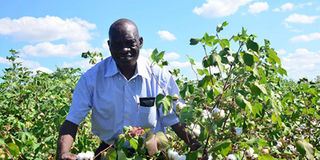Let’s seize the moment, Bt cotton has huge benefits for our farmers

Mr Michael Onyuro admires Bt cotton in Malawi. PHOTO | COURTESY
What you need to know:
- The mainstream scientific consensus has reaffirmed the safety of GM crops.
- In Kenya, eight regulatory agencies have tested the performance of Bt cotton from the inception to field trials in different agro-ecological zones.
In her article, Bt cotton no aid to textiles sector but a trapdoor for unsafe food (DN, Jan 8), Ms Anne Maina seems to forget the sentiments of farmers who look forward to growing the genetically modified Bt cotton.
In the innovative agricultural tools, they see hope for their ruined cotton productivity in this crop bred by public scientists.
Bt cotton protects itself from damage by the African bollworm, reducing the number of pesticide sprays needed from 12 per season to even three.
Pesticides account for 45 percent of the production costs.
Commercialisation of Bt cotton will cut costs, giving poor farmers a chance to get high yields.
PRODUCTIVITY
The government has collaborated with farmers to test the efficacy of Bt cotton, researched for two decades and culminating in the ongoing National Performance Trials by scientists.
My interaction with farmers in western Kenya invalidates Ms Maina’s assertion that Bt cotton is premature and unnecessary. They are awaiting the results of the trials with bated breath.
Sudan and South Africa are planting Bt cotton with farmers being given the option to choose the variety to grow.
Six other African countries are close to commercialisation, even as 64 percent of cotton produced globally is genetically modified.
Sudanese cotton farmers have increased productivity to 1,000kg lint per hectare, or 30 percent.
GM CROPS
When introduced in 2012-15, GE cotton became the most profitable crop and main foreign exchange earner, attracting more farmers.
Bt comprised 95 percent of the area planted in the bounty harvest of 2017.
The article fails to provide evidence that genetic engineering, a modern form of crop modification that reduces farmers’ dependence on pesticides and enhances the health of agricultural systems, is harmful.
The mainstream scientific consensus — such as the US National Academy of Science Royal Society and the UN Food and Agriculture Organisation — has reaffirmed the safety of GM crops.
Ms Maina’s views about genetic engineering are wrong and wildly overstated and fail to offer a strategy to revive Kenya’s once-thriving cotton sector.
MONITORING
The Ministry of Industry, Trade and Cooperatives says only five of the 22 ginneries are operational, producing 25,000 bales against a demand of 200,000. Imports means we are losing out on jobs.
Although Ms Maina casts Burkina Faso’s experience with Bt cotton as a failure, farmers there are lobbying agriculture stakeholders to grow the crop again because it increased their yields and reduced pesticide use.
In Kenya, eight regulatory agencies have tested the performance of Bt cotton from the inception to field trials in different agro-ecological zones.
It is still under the scientists’ watch, its benefits notwithstanding.
If GMO sceptics continue to suffocate the voice of the poor farmer, blocking a product that is farmer-centred, who will speak on their behalf?
Verenardo Meeme, Alliance for Science Fellow, Cornell University, New York, USA, and development communication specialist.




